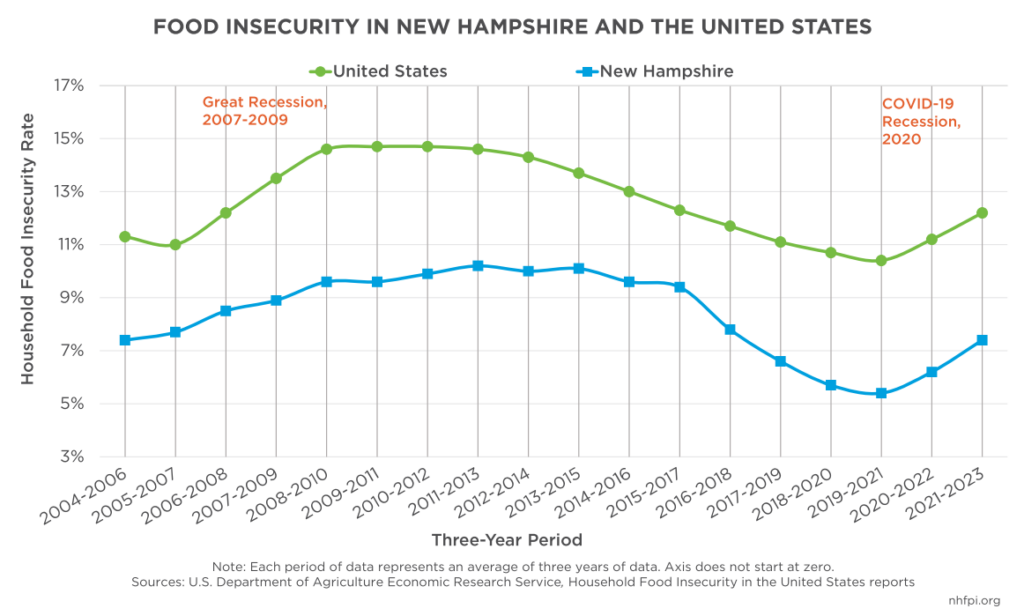Survey data analyzed by the U.S. Department of Agriculture (USDA) provides reliable insights into the number of households experiencing food insecurity across the country and in the Granite State. According to the USDA, food insecurity is defined as when households are unable to provide enough food for one or more household members due to a lack of money or resources. The USDA’s most recent report, released on September 4, suggests that food insecurity has continued to rise following initial declines during the COVID-19 pandemic.
National and New Hampshire Trends
The most recent USDA food insecurity data was collected through the U.S. Census Bureau’s Current Population Survey in 2023. In order to produce more reliable estimates of food insecurity at the state level, the USDA aggregates data into three-year periods, with this report covering state data from 2021 to 2023.
During the 2021-2023 period, approximately 42,300 New Hampshire households, or 7.4 percent of households in the state, were food insecure. While the change from the 2020-2022 period is not statistically significant due to data limitations, the estimated number of households experiencing food insecurity during that prior three-year period was about 35,000 households, or 6.2 percent. Food insecurity during the 2021-2023 period was higher than during 2019-2021 in New Hampshire, including after accounting for key statistical uncertainties associated with survey data. During the 2019-2021 period, the state’s estimated food insecurity rate of 5.4 percent reached its lowest point across the past two decades. Declines in food insecurity during this time were likely due to increased pandemic-related federal assistance programs to help alleviate economic hardships caused by the COVID-19 pandemic, including Economic Impact Payments or “stimulus checks,” and the expansion of the Child Tax Credit, among others. These supports also helped substantially reduce the overall poverty rate in New Hampshire between 2019 and 2021, based on the Supplemental Poverty Measure, and reduced child poverty in the state by half between those two years. While food insecurity in New Hampshire may be increasing, the estimated rate remained slightly lower than rates estimated for the state during the slow recovery from the Great Recession.
During the 2021-2023 period, New Hampshire experienced the lowest estimated rate of food insecurity in the country, although data limitations rendered that point estimate statistically indistinguishable from at least eight other states, including Vermont and Massachusetts. While the food insecurity rate in New Hampshire has been historically lower relative to other states, the national food insecurity rate has followed similar trends over the last few years. Annual national data show that a larger percentage of households were food insecure in 2022 (12.8 percent) and 2023 (13.5 percent), compared to the approximate 10.2 percent who were food insecure in 2021. These national trends and available state-level data suggest that more Granite State households may have been food insecure in 2022 and 2023 relative to 2021.
National USDA data provide a further understanding of the varying effects of food insecurity on the population. Throughout the country, households with incomes below 185 percent of the federal poverty guidelines, those with householders identifying as Black or Hispanic, households with children, and those headed by single parents experienced elevated rates of food insecurity in 2023. Food insecurity was most prominent among single-female-headed households with children, as approximately one in three (34.7 percent) of such households across the country experienced food insecurity. While rates among older adults remained similar from 2022 to 2023, the food insecurity rate for older adults living alone increased from 2020 to 2021, while other households experienced a decline during this time.
The number of children in food insecure households has increased by about 49 percent since 2021, with approximately 19.2 percent of children in U.S. households experiencing food insecurity in 2023. Following similar trends to overall national food insecurity rates, the number of children who were food insecure declined from 2020 to 2021, likely due to pandemic-related federal programs providing assistance for families across the country.
Other Measures of Food Insecurity
Other measures of food insecurity can provide further insight into how many Granite Staters may be experiencing hardship. The U.S. Census Bureau’s Household Pulse Survey (HPS) includes a measure describing household food sufficiency. This measure of “food sufficiency” is different from the definition for “food security,” and the HPS asks, among other questions, whether respondents had enough to eat in the prior seven days. The HPS data show that, on average during 2022, approximately 6.7 percent of Granite State adults reported that they sometimes or often did not have enough to eat during the prior seven days. Modeled estimates based on other data and research made available through Feeding America’s Map the Meal Gap suggested that approximately 135,200 people across the state were food insecure in 2022, an increase of about 44 percent from its 2021 estimate. Both measures of food insecurity were similar to that found in the USDA’s most recent report; using the U.S. Census Bureau’s 2022 population estimates and the state’s average household size of 2.44 people, about 103,100 people may have experienced food insecurity each year during the 2021-2023 cycle, based on the USDA data.
More recent data from the HPS suggests that food insecurity has remained similar across New Hampshire over the last two years. According to data collected from January through October 2023 and from the first seven months of 2024, an average of approximately seven percent of the state’s households sometimes or often did not have enough food to eat in the seven days before they were surveyed. These HPS data, combined with the latest USDA survey and Feeding America’s analysis, suggest that food insecurity has increased since 2021, and may have remained elevated. Increases in the number of households who are food insecure suggest that hardship rebounded following the expiration of federal pandemic-related assistance, reflecting increased economic difficulties among residents across the Granite State.
– Jessica Williams, Policy Analyst

